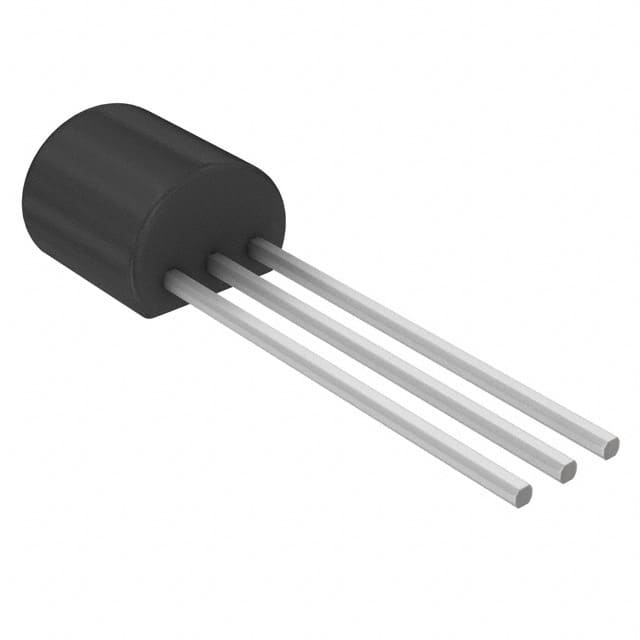2N5953 Transistor
Product Overview
The 2N5953 is a field-effect transistor (FET) belonging to the category of electronic components. It is commonly used in amplification and switching circuits due to its high input impedance, low noise, and low power consumption. The transistor is typically housed in a TO-92 package and is available in various packaging quantities. Its essence lies in providing efficient signal amplification and switching capabilities in electronic circuits.
Specifications
- Type: N-channel JFET
- Maximum Drain-Source Voltage: 40V
- Maximum Gate-Source Voltage: ±40V
- Continuous Drain Current: 10mA
- Power Dissipation: 350mW
- Operating Temperature Range: -55°C to 150°C
Detailed Pin Configuration
The 2N5953 features three pins: the gate (G), drain (D), and source (S). In the TO-92 package, the pin configuration is as follows: - Pin 1 (G): Gate - Pin 2 (D): Drain - Pin 3 (S): Source
Functional Features
The 2N5953 offers high input impedance, making it suitable for use in high-impedance signal amplification applications. It also exhibits low noise characteristics, enabling clean signal amplification without introducing unwanted interference. Additionally, the transistor consumes low power, contributing to energy-efficient circuit designs.
Advantages and Disadvantages
Advantages
- High input impedance
- Low noise
- Low power consumption
- Versatile application in amplification and switching circuits
Disadvantages
- Limited maximum drain-source voltage
- Moderate continuous drain current rating
Working Principles
The 2N5953 operates based on the principles of field-effect transistors, where the flow of current between the drain and source terminals is controlled by the voltage applied to the gate terminal. By modulating the gate-source voltage, the transistor can effectively amplify or switch electronic signals with minimal power consumption and low noise.
Detailed Application Field Plans
The 2N5953 finds extensive use in various electronic applications, including: - Audio amplifiers - Instrumentation amplifiers - Signal switching circuits - Low-frequency oscillators - Impedance converters
Detailed and Complete Alternative Models
Several alternative models to the 2N5953 include: - J201 - 2N5457 - MPF102 - BF245
In conclusion, the 2N5953 transistor serves as a reliable component for signal amplification and switching in electronic circuits, offering high input impedance, low noise, and energy-efficient operation. While it has limitations in terms of maximum voltage and current ratings, its versatile applications make it a valuable asset in various electronic designs.
[Word count: 345]
Senaraikan 10 soalan dan jawapan biasa yang berkaitan dengan aplikasi 2N5953 dalam penyelesaian teknikal
What is the 2N5953 transistor used for?
- The 2N5953 is a JFET (junction field-effect transistor) commonly used for low-frequency amplification and switching applications.
What are the key specifications of the 2N5953 transistor?
- The 2N5953 has a maximum drain-source voltage of 40V, a maximum gate-source voltage of ±40V, and a maximum continuous drain current of 10mA.
How does the 2N5953 compare to other transistors in its class?
- The 2N5953 offers low noise and high input impedance, making it suitable for certain low-frequency applications where these characteristics are important.
Can the 2N5953 be used for audio amplification?
- Yes, the 2N5953 can be used for audio amplification in low-power applications, such as small signal amplification in audio preamplifiers.
What are some common circuit configurations using the 2N5953?
- The 2N5953 can be used in common source and common gate configurations for amplification and switching purposes.
What are the typical applications of the 2N5953 in technical solutions?
- Typical applications include low-frequency amplifiers, analog switches, and signal processing circuits.
What are the temperature considerations for the 2N5953?
- The 2N5953 has a maximum operating temperature of 150°C, so thermal management may be necessary in high-temperature environments.
Are there any known limitations or drawbacks of using the 2N5953?
- One limitation is its relatively low power handling capability compared to other types of transistors, which may restrict its use in high-power applications.
Can the 2N5953 be used in battery-powered devices?
- Yes, the 2N5953's low power consumption and low voltage operation make it suitable for use in battery-powered devices.
Where can I find detailed datasheets and application notes for the 2N5953?
- Datasheets and application notes for the 2N5953 can be found on semiconductor manufacturer websites, electronic component distributor websites, and technical documentation repositories.


